SUSS PSY390 Research Methods Assignment: Analysis and Critique
VerifiedAdded on 2023/04/20
|7
|1833
|156
Report
AI Summary
This report analyzes a research methods assignment, focusing on a study examining the relationship between narcissism and social media behavior. The assignment evaluates the research approach and design, specifically the online recruitment method and snowball sampling technique. It critiques the appropriateness and representativeness of the sample, highlighting potential biases and suggesting improvements. Furthermore, the report assesses the measurement techniques used, including the frequency of selfie posting and perceived attractiveness, and proposes alternative methods like open-ended questionnaires and interviews to enhance item validity and response accuracy. The report concludes by summarizing the study's strengths and weaknesses, offering insights into the research process and its various components.
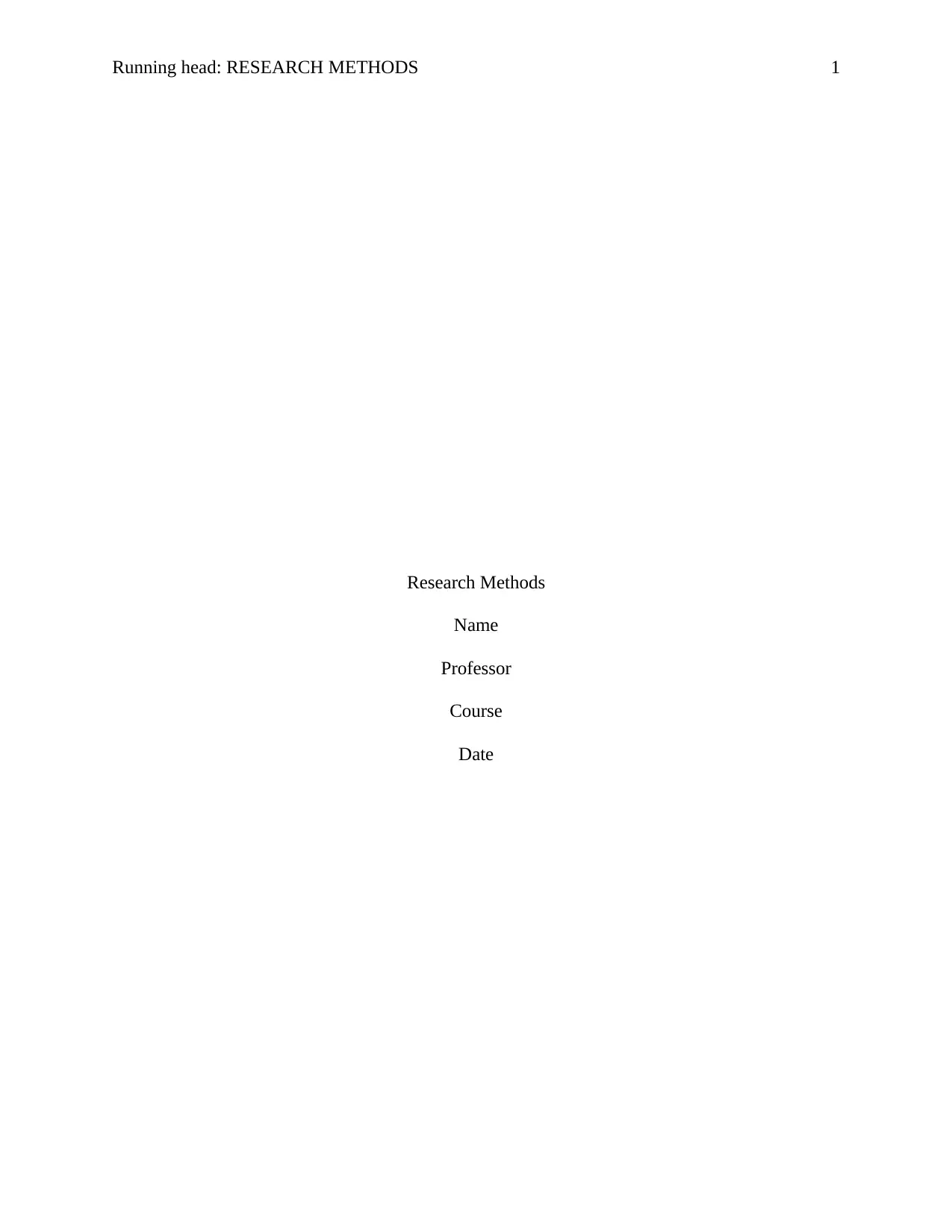
Running head: RESEARCH METHODS 1
Research Methods
Name
Professor
Course
Date
Research Methods
Name
Professor
Course
Date
Paraphrase This Document
Need a fresh take? Get an instant paraphrase of this document with our AI Paraphraser
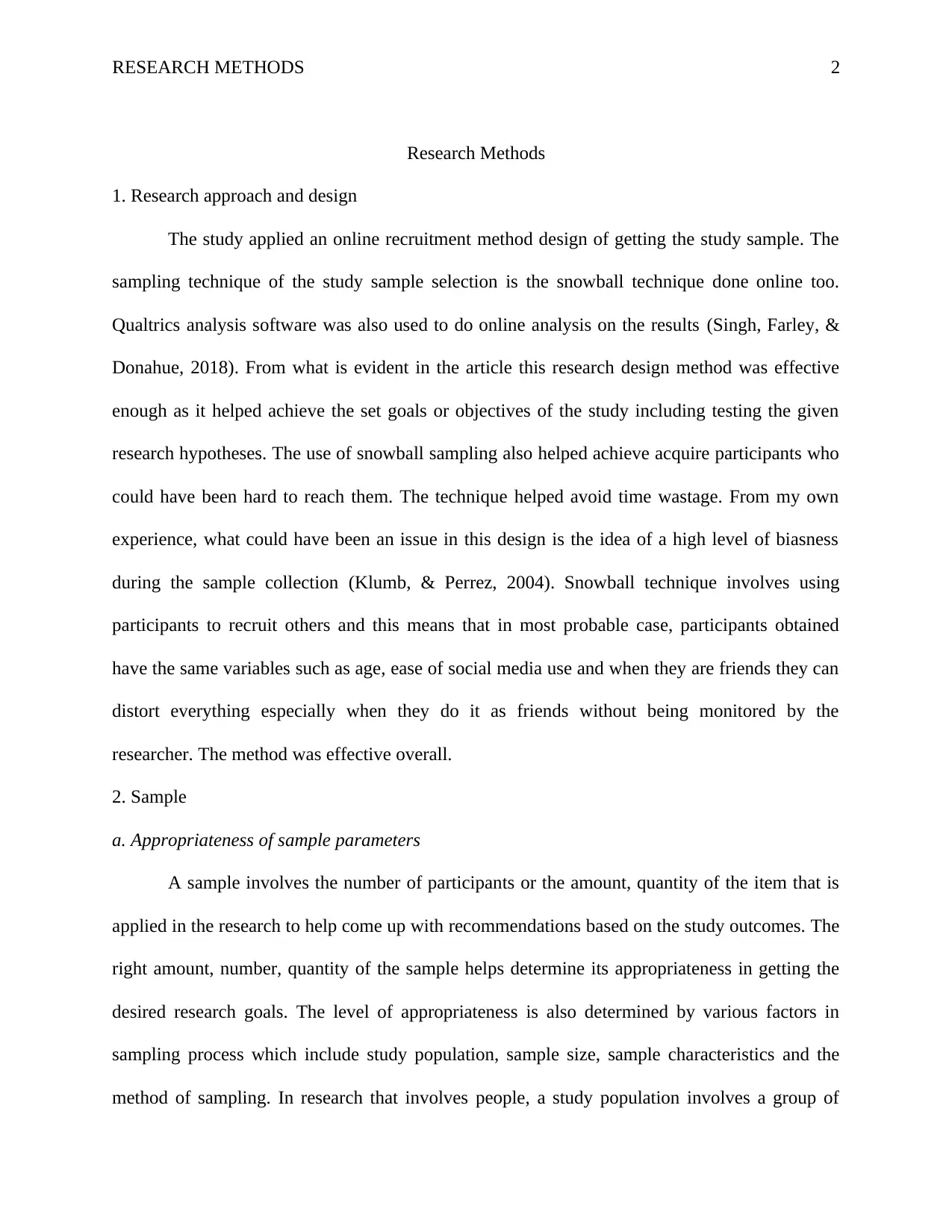
RESEARCH METHODS 2
Research Methods
1. Research approach and design
The study applied an online recruitment method design of getting the study sample. The
sampling technique of the study sample selection is the snowball technique done online too.
Qualtrics analysis software was also used to do online analysis on the results (Singh, Farley, &
Donahue, 2018). From what is evident in the article this research design method was effective
enough as it helped achieve the set goals or objectives of the study including testing the given
research hypotheses. The use of snowball sampling also helped achieve acquire participants who
could have been hard to reach them. The technique helped avoid time wastage. From my own
experience, what could have been an issue in this design is the idea of a high level of biasness
during the sample collection (Klumb, & Perrez, 2004). Snowball technique involves using
participants to recruit others and this means that in most probable case, participants obtained
have the same variables such as age, ease of social media use and when they are friends they can
distort everything especially when they do it as friends without being monitored by the
researcher. The method was effective overall.
2. Sample
a. Appropriateness of sample parameters
A sample involves the number of participants or the amount, quantity of the item that is
applied in the research to help come up with recommendations based on the study outcomes. The
right amount, number, quantity of the sample helps determine its appropriateness in getting the
desired research goals. The level of appropriateness is also determined by various factors in
sampling process which include study population, sample size, sample characteristics and the
method of sampling. In research that involves people, a study population involves a group of
Research Methods
1. Research approach and design
The study applied an online recruitment method design of getting the study sample. The
sampling technique of the study sample selection is the snowball technique done online too.
Qualtrics analysis software was also used to do online analysis on the results (Singh, Farley, &
Donahue, 2018). From what is evident in the article this research design method was effective
enough as it helped achieve the set goals or objectives of the study including testing the given
research hypotheses. The use of snowball sampling also helped achieve acquire participants who
could have been hard to reach them. The technique helped avoid time wastage. From my own
experience, what could have been an issue in this design is the idea of a high level of biasness
during the sample collection (Klumb, & Perrez, 2004). Snowball technique involves using
participants to recruit others and this means that in most probable case, participants obtained
have the same variables such as age, ease of social media use and when they are friends they can
distort everything especially when they do it as friends without being monitored by the
researcher. The method was effective overall.
2. Sample
a. Appropriateness of sample parameters
A sample involves the number of participants or the amount, quantity of the item that is
applied in the research to help come up with recommendations based on the study outcomes. The
right amount, number, quantity of the sample helps determine its appropriateness in getting the
desired research goals. The level of appropriateness is also determined by various factors in
sampling process which include study population, sample size, sample characteristics and the
method of sampling. In research that involves people, a study population involves a group of
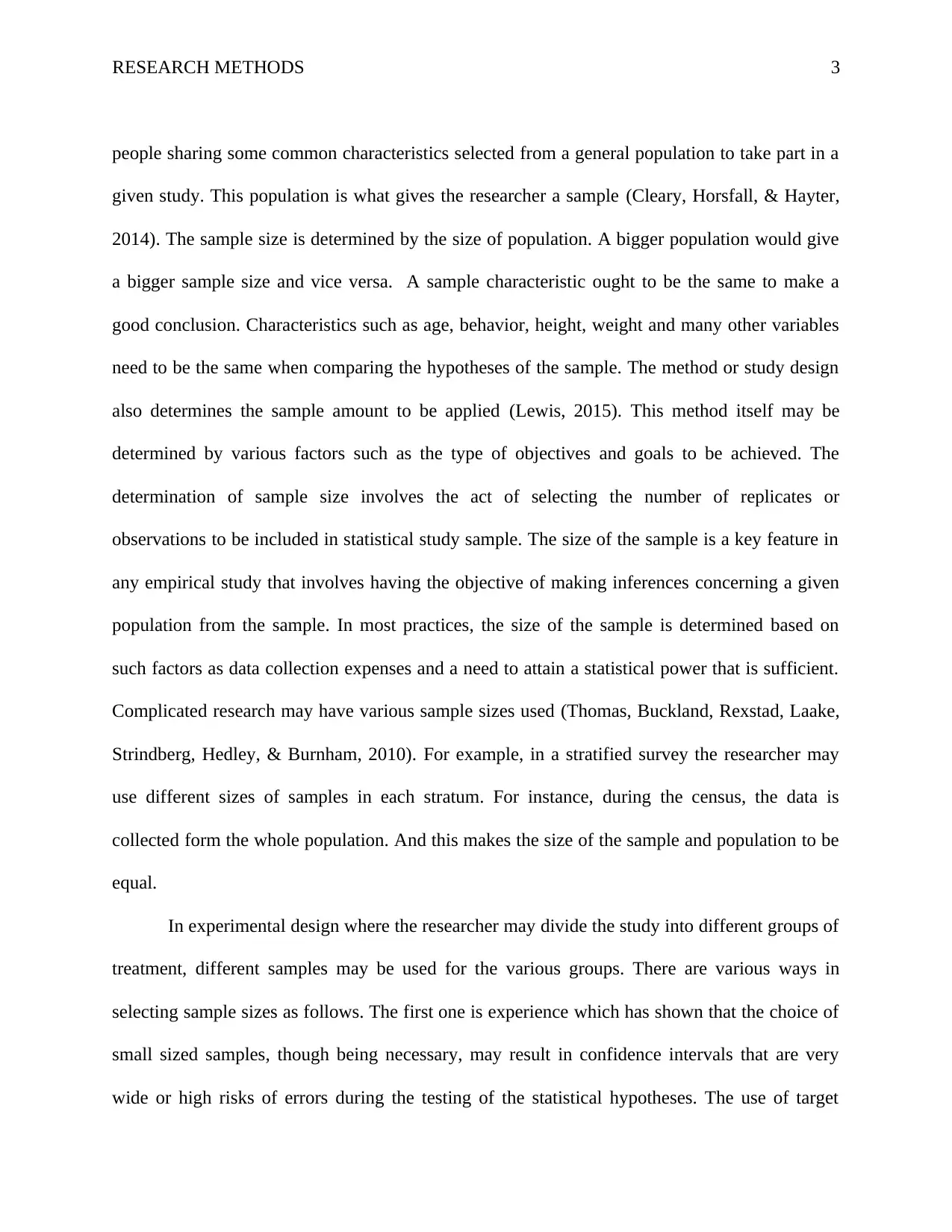
RESEARCH METHODS 3
people sharing some common characteristics selected from a general population to take part in a
given study. This population is what gives the researcher a sample (Cleary, Horsfall, & Hayter,
2014). The sample size is determined by the size of population. A bigger population would give
a bigger sample size and vice versa. A sample characteristic ought to be the same to make a
good conclusion. Characteristics such as age, behavior, height, weight and many other variables
need to be the same when comparing the hypotheses of the sample. The method or study design
also determines the sample amount to be applied (Lewis, 2015). This method itself may be
determined by various factors such as the type of objectives and goals to be achieved. The
determination of sample size involves the act of selecting the number of replicates or
observations to be included in statistical study sample. The size of the sample is a key feature in
any empirical study that involves having the objective of making inferences concerning a given
population from the sample. In most practices, the size of the sample is determined based on
such factors as data collection expenses and a need to attain a statistical power that is sufficient.
Complicated research may have various sample sizes used (Thomas, Buckland, Rexstad, Laake,
Strindberg, Hedley, & Burnham, 2010). For example, in a stratified survey the researcher may
use different sizes of samples in each stratum. For instance, during the census, the data is
collected form the whole population. And this makes the size of the sample and population to be
equal.
In experimental design where the researcher may divide the study into different groups of
treatment, different samples may be used for the various groups. There are various ways in
selecting sample sizes as follows. The first one is experience which has shown that the choice of
small sized samples, though being necessary, may result in confidence intervals that are very
wide or high risks of errors during the testing of the statistical hypotheses. The use of target
people sharing some common characteristics selected from a general population to take part in a
given study. This population is what gives the researcher a sample (Cleary, Horsfall, & Hayter,
2014). The sample size is determined by the size of population. A bigger population would give
a bigger sample size and vice versa. A sample characteristic ought to be the same to make a
good conclusion. Characteristics such as age, behavior, height, weight and many other variables
need to be the same when comparing the hypotheses of the sample. The method or study design
also determines the sample amount to be applied (Lewis, 2015). This method itself may be
determined by various factors such as the type of objectives and goals to be achieved. The
determination of sample size involves the act of selecting the number of replicates or
observations to be included in statistical study sample. The size of the sample is a key feature in
any empirical study that involves having the objective of making inferences concerning a given
population from the sample. In most practices, the size of the sample is determined based on
such factors as data collection expenses and a need to attain a statistical power that is sufficient.
Complicated research may have various sample sizes used (Thomas, Buckland, Rexstad, Laake,
Strindberg, Hedley, & Burnham, 2010). For example, in a stratified survey the researcher may
use different sizes of samples in each stratum. For instance, during the census, the data is
collected form the whole population. And this makes the size of the sample and population to be
equal.
In experimental design where the researcher may divide the study into different groups of
treatment, different samples may be used for the various groups. There are various ways in
selecting sample sizes as follows. The first one is experience which has shown that the choice of
small sized samples, though being necessary, may result in confidence intervals that are very
wide or high risks of errors during the testing of the statistical hypotheses. The use of target
⊘ This is a preview!⊘
Do you want full access?
Subscribe today to unlock all pages.

Trusted by 1+ million students worldwide
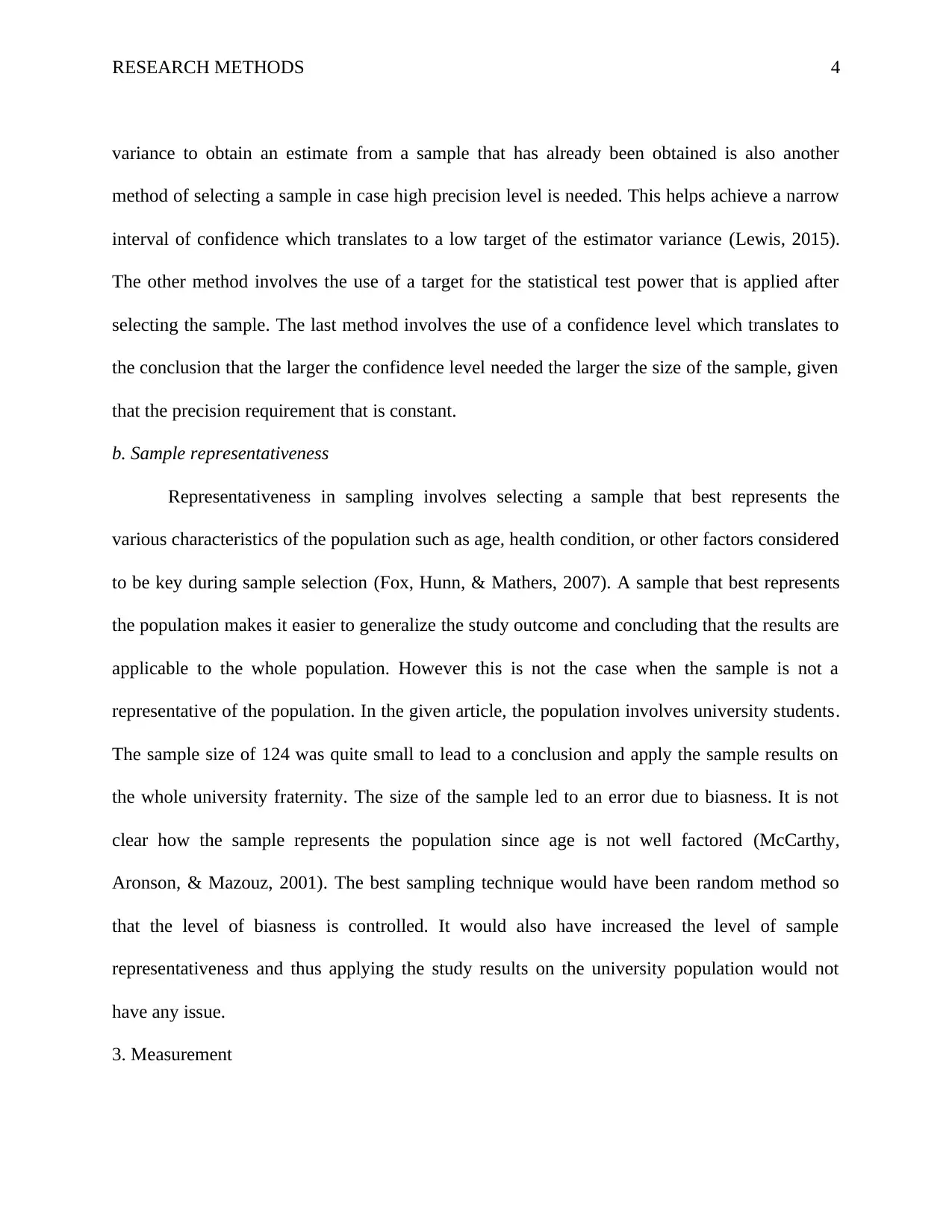
RESEARCH METHODS 4
variance to obtain an estimate from a sample that has already been obtained is also another
method of selecting a sample in case high precision level is needed. This helps achieve a narrow
interval of confidence which translates to a low target of the estimator variance (Lewis, 2015).
The other method involves the use of a target for the statistical test power that is applied after
selecting the sample. The last method involves the use of a confidence level which translates to
the conclusion that the larger the confidence level needed the larger the size of the sample, given
that the precision requirement that is constant.
b. Sample representativeness
Representativeness in sampling involves selecting a sample that best represents the
various characteristics of the population such as age, health condition, or other factors considered
to be key during sample selection (Fox, Hunn, & Mathers, 2007). A sample that best represents
the population makes it easier to generalize the study outcome and concluding that the results are
applicable to the whole population. However this is not the case when the sample is not a
representative of the population. In the given article, the population involves university students.
The sample size of 124 was quite small to lead to a conclusion and apply the sample results on
the whole university fraternity. The size of the sample led to an error due to biasness. It is not
clear how the sample represents the population since age is not well factored (McCarthy,
Aronson, & Mazouz, 2001). The best sampling technique would have been random method so
that the level of biasness is controlled. It would also have increased the level of sample
representativeness and thus applying the study results on the university population would not
have any issue.
3. Measurement
variance to obtain an estimate from a sample that has already been obtained is also another
method of selecting a sample in case high precision level is needed. This helps achieve a narrow
interval of confidence which translates to a low target of the estimator variance (Lewis, 2015).
The other method involves the use of a target for the statistical test power that is applied after
selecting the sample. The last method involves the use of a confidence level which translates to
the conclusion that the larger the confidence level needed the larger the size of the sample, given
that the precision requirement that is constant.
b. Sample representativeness
Representativeness in sampling involves selecting a sample that best represents the
various characteristics of the population such as age, health condition, or other factors considered
to be key during sample selection (Fox, Hunn, & Mathers, 2007). A sample that best represents
the population makes it easier to generalize the study outcome and concluding that the results are
applicable to the whole population. However this is not the case when the sample is not a
representative of the population. In the given article, the population involves university students.
The sample size of 124 was quite small to lead to a conclusion and apply the sample results on
the whole university fraternity. The size of the sample led to an error due to biasness. It is not
clear how the sample represents the population since age is not well factored (McCarthy,
Aronson, & Mazouz, 2001). The best sampling technique would have been random method so
that the level of biasness is controlled. It would also have increased the level of sample
representativeness and thus applying the study results on the university population would not
have any issue.
3. Measurement
Paraphrase This Document
Need a fresh take? Get an instant paraphrase of this document with our AI Paraphraser
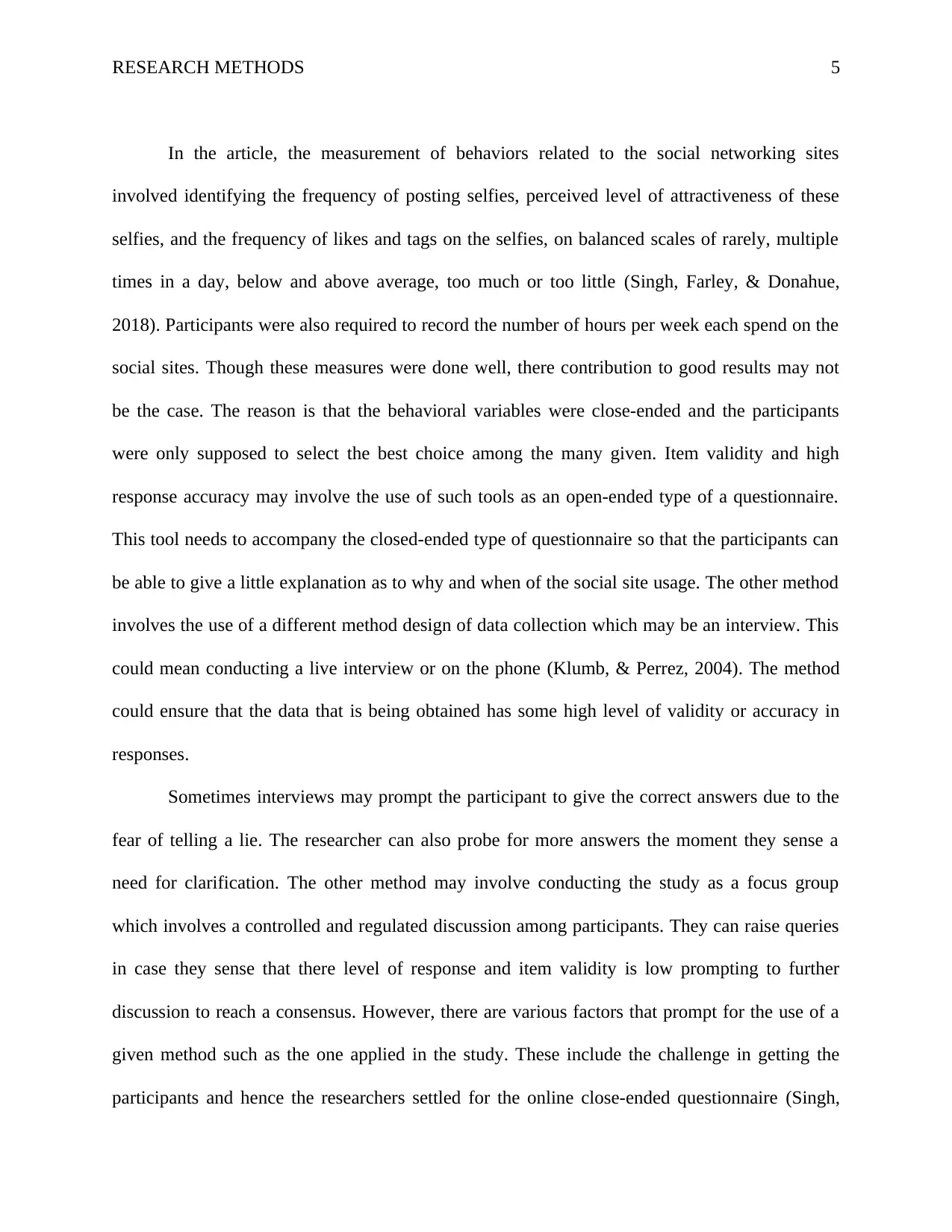
RESEARCH METHODS 5
In the article, the measurement of behaviors related to the social networking sites
involved identifying the frequency of posting selfies, perceived level of attractiveness of these
selfies, and the frequency of likes and tags on the selfies, on balanced scales of rarely, multiple
times in a day, below and above average, too much or too little (Singh, Farley, & Donahue,
2018). Participants were also required to record the number of hours per week each spend on the
social sites. Though these measures were done well, there contribution to good results may not
be the case. The reason is that the behavioral variables were close-ended and the participants
were only supposed to select the best choice among the many given. Item validity and high
response accuracy may involve the use of such tools as an open-ended type of a questionnaire.
This tool needs to accompany the closed-ended type of questionnaire so that the participants can
be able to give a little explanation as to why and when of the social site usage. The other method
involves the use of a different method design of data collection which may be an interview. This
could mean conducting a live interview or on the phone (Klumb, & Perrez, 2004). The method
could ensure that the data that is being obtained has some high level of validity or accuracy in
responses.
Sometimes interviews may prompt the participant to give the correct answers due to the
fear of telling a lie. The researcher can also probe for more answers the moment they sense a
need for clarification. The other method may involve conducting the study as a focus group
which involves a controlled and regulated discussion among participants. They can raise queries
in case they sense that there level of response and item validity is low prompting to further
discussion to reach a consensus. However, there are various factors that prompt for the use of a
given method such as the one applied in the study. These include the challenge in getting the
participants and hence the researchers settled for the online close-ended questionnaire (Singh,
In the article, the measurement of behaviors related to the social networking sites
involved identifying the frequency of posting selfies, perceived level of attractiveness of these
selfies, and the frequency of likes and tags on the selfies, on balanced scales of rarely, multiple
times in a day, below and above average, too much or too little (Singh, Farley, & Donahue,
2018). Participants were also required to record the number of hours per week each spend on the
social sites. Though these measures were done well, there contribution to good results may not
be the case. The reason is that the behavioral variables were close-ended and the participants
were only supposed to select the best choice among the many given. Item validity and high
response accuracy may involve the use of such tools as an open-ended type of a questionnaire.
This tool needs to accompany the closed-ended type of questionnaire so that the participants can
be able to give a little explanation as to why and when of the social site usage. The other method
involves the use of a different method design of data collection which may be an interview. This
could mean conducting a live interview or on the phone (Klumb, & Perrez, 2004). The method
could ensure that the data that is being obtained has some high level of validity or accuracy in
responses.
Sometimes interviews may prompt the participant to give the correct answers due to the
fear of telling a lie. The researcher can also probe for more answers the moment they sense a
need for clarification. The other method may involve conducting the study as a focus group
which involves a controlled and regulated discussion among participants. They can raise queries
in case they sense that there level of response and item validity is low prompting to further
discussion to reach a consensus. However, there are various factors that prompt for the use of a
given method such as the one applied in the study. These include the challenge in getting the
participants and hence the researchers settled for the online close-ended questionnaire (Singh,
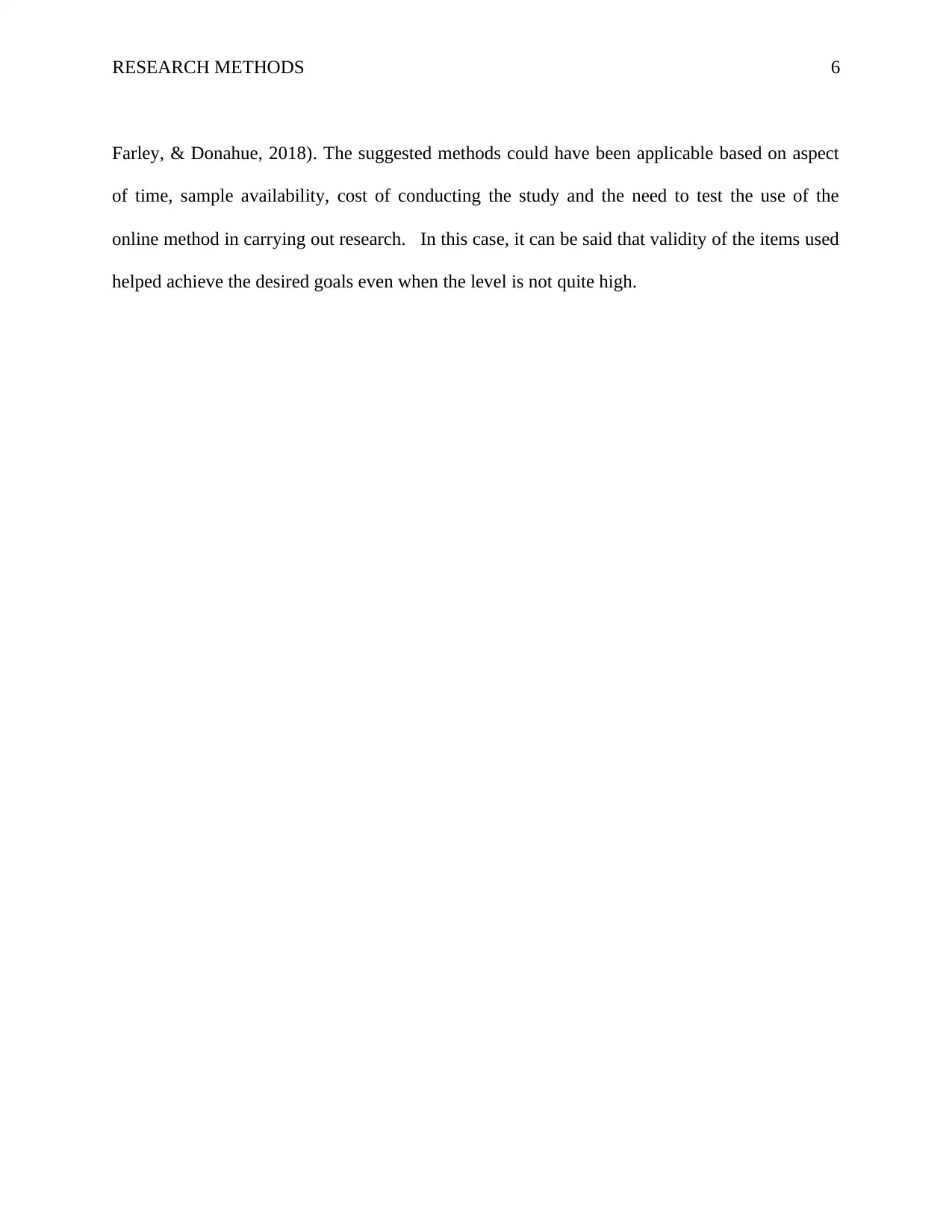
RESEARCH METHODS 6
Farley, & Donahue, 2018). The suggested methods could have been applicable based on aspect
of time, sample availability, cost of conducting the study and the need to test the use of the
online method in carrying out research. In this case, it can be said that validity of the items used
helped achieve the desired goals even when the level is not quite high.
Farley, & Donahue, 2018). The suggested methods could have been applicable based on aspect
of time, sample availability, cost of conducting the study and the need to test the use of the
online method in carrying out research. In this case, it can be said that validity of the items used
helped achieve the desired goals even when the level is not quite high.
⊘ This is a preview!⊘
Do you want full access?
Subscribe today to unlock all pages.

Trusted by 1+ million students worldwide
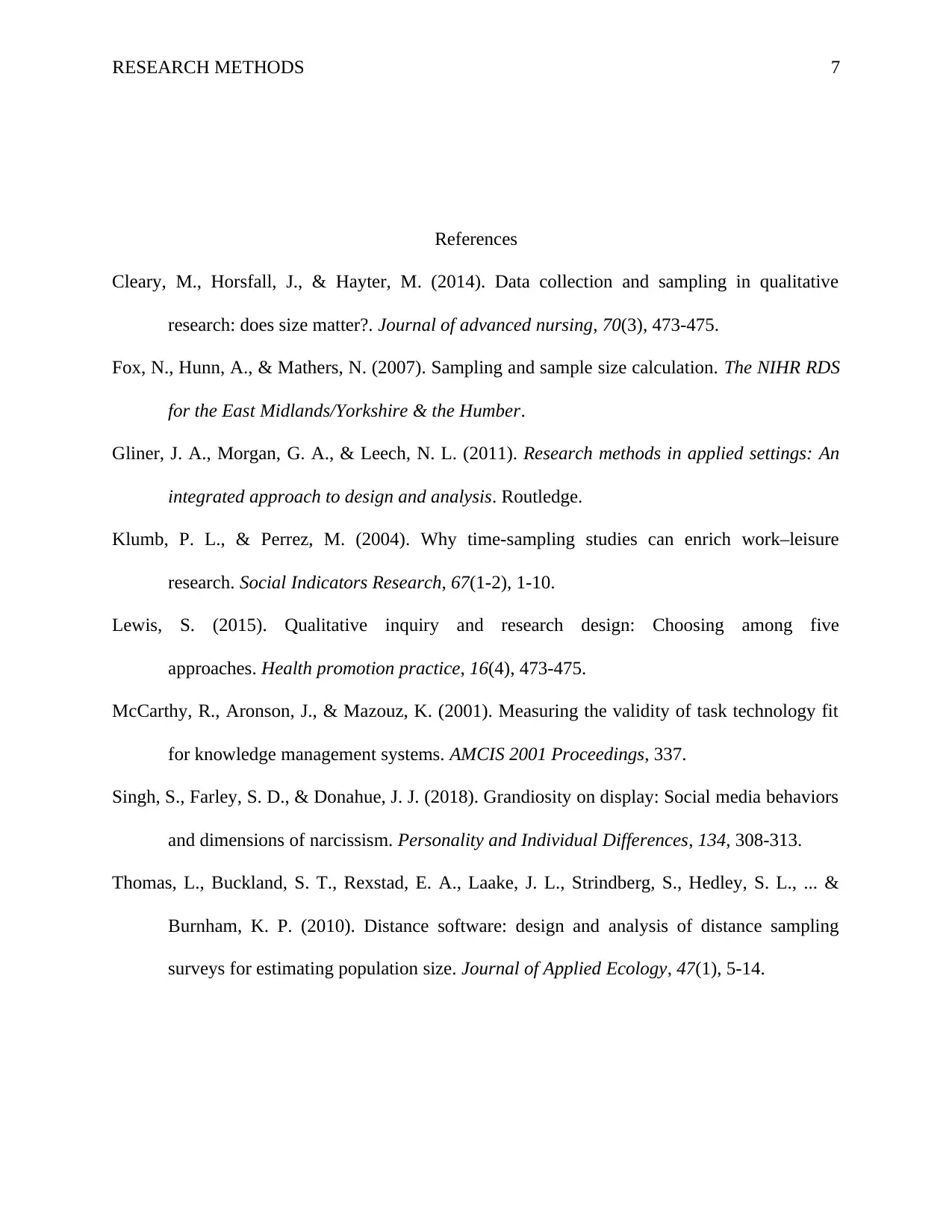
RESEARCH METHODS 7
References
Cleary, M., Horsfall, J., & Hayter, M. (2014). Data collection and sampling in qualitative
research: does size matter?. Journal of advanced nursing, 70(3), 473-475.
Fox, N., Hunn, A., & Mathers, N. (2007). Sampling and sample size calculation. The NIHR RDS
for the East Midlands/Yorkshire & the Humber.
Gliner, J. A., Morgan, G. A., & Leech, N. L. (2011). Research methods in applied settings: An
integrated approach to design and analysis. Routledge.
Klumb, P. L., & Perrez, M. (2004). Why time-sampling studies can enrich work–leisure
research. Social Indicators Research, 67(1-2), 1-10.
Lewis, S. (2015). Qualitative inquiry and research design: Choosing among five
approaches. Health promotion practice, 16(4), 473-475.
McCarthy, R., Aronson, J., & Mazouz, K. (2001). Measuring the validity of task technology fit
for knowledge management systems. AMCIS 2001 Proceedings, 337.
Singh, S., Farley, S. D., & Donahue, J. J. (2018). Grandiosity on display: Social media behaviors
and dimensions of narcissism. Personality and Individual Differences, 134, 308-313.
Thomas, L., Buckland, S. T., Rexstad, E. A., Laake, J. L., Strindberg, S., Hedley, S. L., ... &
Burnham, K. P. (2010). Distance software: design and analysis of distance sampling
surveys for estimating population size. Journal of Applied Ecology, 47(1), 5-14.
References
Cleary, M., Horsfall, J., & Hayter, M. (2014). Data collection and sampling in qualitative
research: does size matter?. Journal of advanced nursing, 70(3), 473-475.
Fox, N., Hunn, A., & Mathers, N. (2007). Sampling and sample size calculation. The NIHR RDS
for the East Midlands/Yorkshire & the Humber.
Gliner, J. A., Morgan, G. A., & Leech, N. L. (2011). Research methods in applied settings: An
integrated approach to design and analysis. Routledge.
Klumb, P. L., & Perrez, M. (2004). Why time-sampling studies can enrich work–leisure
research. Social Indicators Research, 67(1-2), 1-10.
Lewis, S. (2015). Qualitative inquiry and research design: Choosing among five
approaches. Health promotion practice, 16(4), 473-475.
McCarthy, R., Aronson, J., & Mazouz, K. (2001). Measuring the validity of task technology fit
for knowledge management systems. AMCIS 2001 Proceedings, 337.
Singh, S., Farley, S. D., & Donahue, J. J. (2018). Grandiosity on display: Social media behaviors
and dimensions of narcissism. Personality and Individual Differences, 134, 308-313.
Thomas, L., Buckland, S. T., Rexstad, E. A., Laake, J. L., Strindberg, S., Hedley, S. L., ... &
Burnham, K. P. (2010). Distance software: design and analysis of distance sampling
surveys for estimating population size. Journal of Applied Ecology, 47(1), 5-14.
1 out of 7
Related Documents
Your All-in-One AI-Powered Toolkit for Academic Success.
+13062052269
info@desklib.com
Available 24*7 on WhatsApp / Email
![[object Object]](/_next/static/media/star-bottom.7253800d.svg)
Unlock your academic potential
Copyright © 2020–2025 A2Z Services. All Rights Reserved. Developed and managed by ZUCOL.





